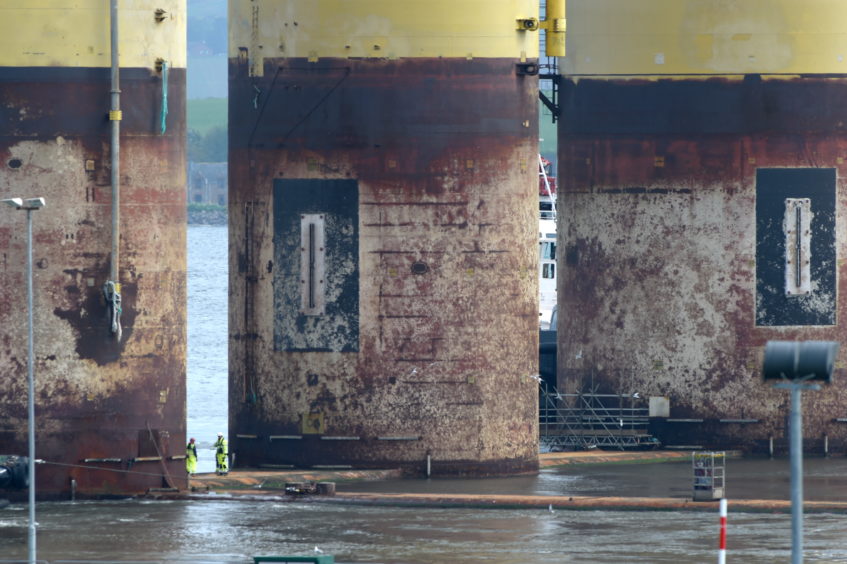
A project to remove an “eyesore” from the Cromarty Firth has stalled, having been plagued by business disputes and a flurry of health and safety orders.
But Nerida, the company in charge of the Hutton project, has said it is confident of finally getting back on track despite the tribulations.
Work got underway last year to remove the 20,000-tonne Hutton structure – a hull and six legs known, also known as a tension leg platform (TLP) – which had been deserted in the channel in 2009.
After changing hands several times, it was finally acquired by freight specialist Nerida and Messiah Decommissioning, who vowed to complete its dismantling at the Queen’s Dock site at the Port of Cromarty Firth.
Beginning in May 2021, the operation was expected to last 12 months and had the backing of stakeholders including the Scottish Environmental Protection Agency (SEPA), the then-Oil and Gas Authority and the port management.
However, more than a year on, the project remains unfinished, having been stalled by a contractual dispute, the departure of contractors and a series of health and safety orders.
Chief amongst these developments is the loss of venture partner Messiah which, according to Nerida managing director John Townley, left the project following an unspecified “contractual dispute” between the two firms, leaving Nerida with sole control of the asset.
This was confirmed by Messiah chief executive Tony O’Sullivan, who said his company had removed several thousand tonnes of scrap from the site in December, before handing the hull back to Nerida in early January.
Messiah no longer has any involvement in the project.
Mr Townley said Nerida had then appointed an unnamed subcontractor to carry out the work, only to have work stopped by the Health and Safety Executive (HSE) – an intervention he suggested was related to the competence of the newly appointed firm.
“We had a big problem in that I got certain people to come in to do the job, which I believed they were capable of doing, but the HSE came down and shut us down,” he explained. “So at that point in time, I had to change the team.”
HSE inspectors issued the site with five notices in late April 2022, two of which called for an immediate stoppage of work.
HSE prohibition notices show that Nerida and its contractors “failed to ensure that the demolition process for the Hutton platform take into account structural issues prior to cutting and detaching elements leading to instability of the structure.”
A second order said they had “failed to ensure that effective planning, management and monitoring are in place on site,” that activities were “poorly controlled” and that risks including “falls from height, structure stability, drowning and fire” were not adequately controlled.
Improvement orders were also issued for insufficient fire risk assessments, failure to assess the risks from fumes generated during the steel burning process and an assessment that contractors had “failed to ensure that persons working [on] site have the skills, knowledge and experience to fulfill the roles they have been appointed to undertake.”
The HSE confirmed that the temporary shutdown of the site in April was as a result of its enforcement action.
A spokesperson added: “HSE has been involved with a pro-active intervention with the owner of the Hutton Hull for over 12 months as part of a wider strategy to engage with the emerging sector of decommissioning and dismantling offshore structures.”
It pointed to a guidance document outlining how it oversees interventions in decommissioning operations.
‘It should’ve been demolished now’
Following co-operation with the HSE, work at the Hutton resumed in late May, with Nerida taking sole oversight of the operation.
Speaking with Energy Voice in early June, Mr Townley acknowledged the process had not gone as planned.
“This has been a difficult process for us and for everybody, and it’s not gone well.
“It should’ve been demolished now, it should be a few bits and pieces left floating,” he said.
“What I’ve learned from it is that you can’t do this half-cocked, you’ve got to bring the right people in.”
However, he is confident the job will be completed “by the end of the year”.
Around 16 people are currently working on the project, not including external consultants, he said.
As of the time of writing, the fourth of the TLP’s six legs is about to be demolished, leaving three legs and the 95 square metre substructure.
Once all remaining towers are dismantled, Mr Townley said attention would turn to the floating pontoons, which the team plans to cut into sections that could be lifted onto the quayside for break up.
Despite the considerable setbacks, Mr Townley also remained optimistic about the wider potential of the decommissioning sector.
“It’s a very interesting project and worthwhile being involved in. The key issue is being able to make it financially worthwhile,” he said.
“We’re not a big company, it’s a fairly small operation… this is a new thing we’ve taken on – out of necessity – but the further we go along I can see more opportunities in the area.”
The Port of Cromarty Firth declined to comment on the project.
 © DCT Media
© DCT Media © DCT Media/Sandy McCook
© DCT Media/Sandy McCook